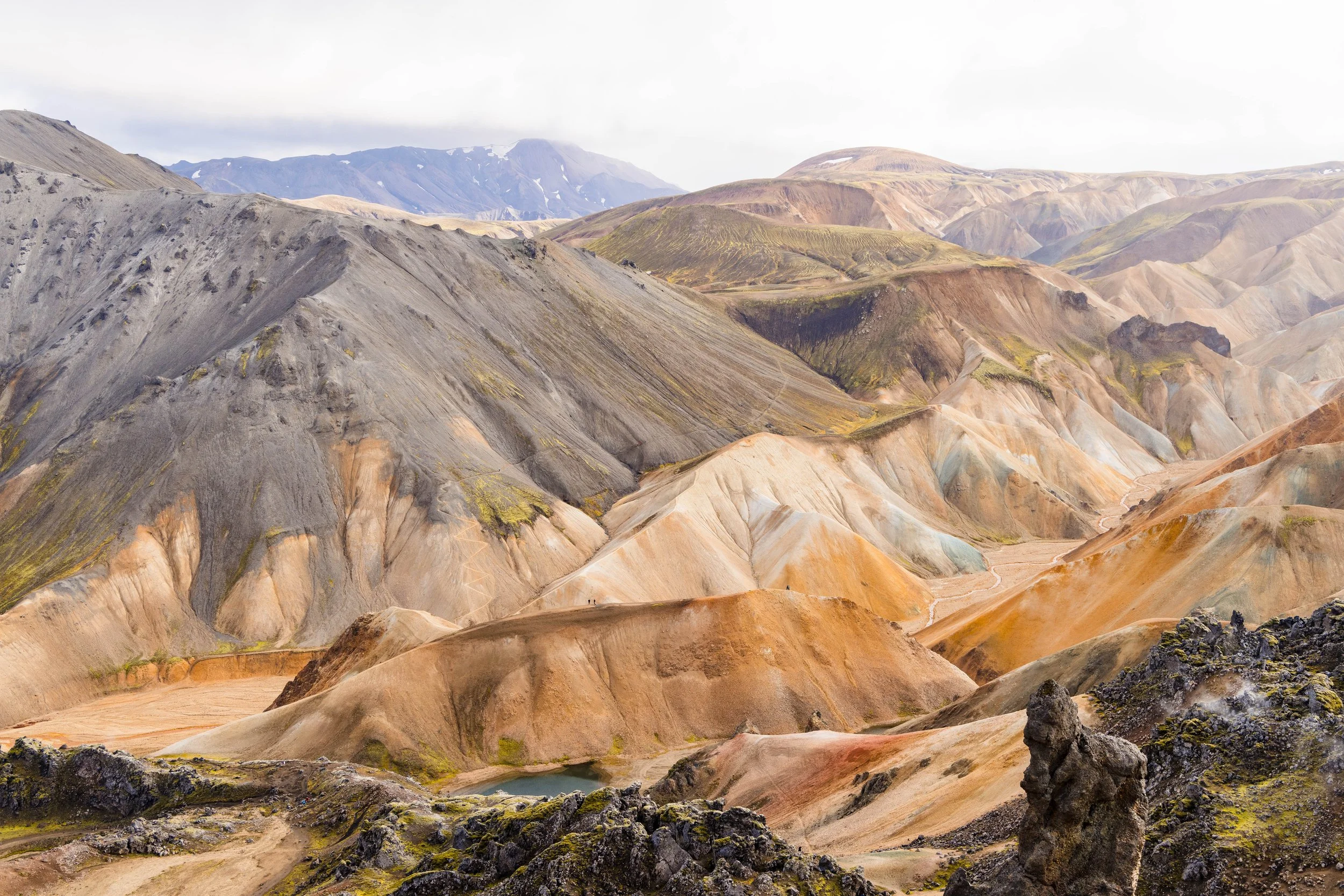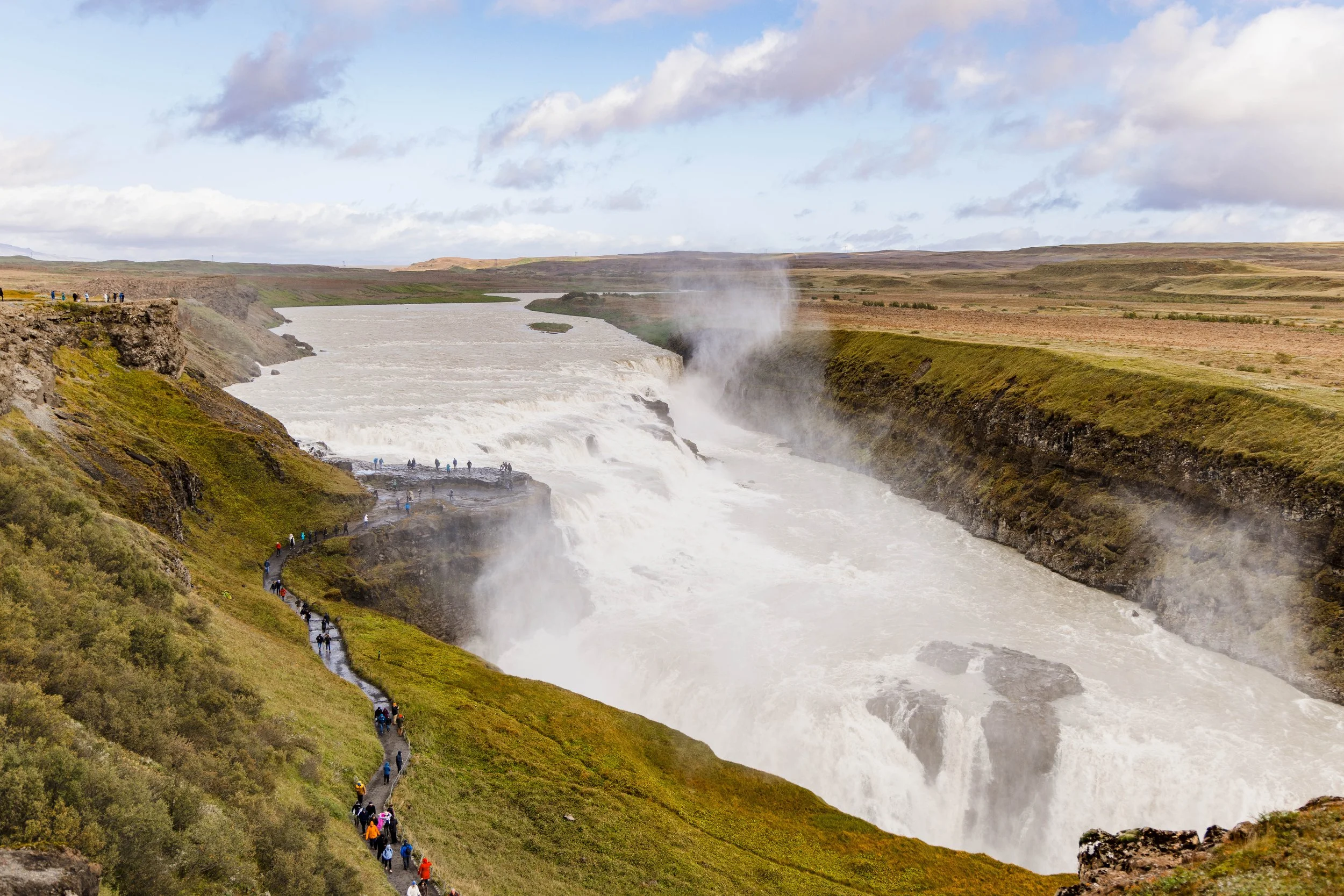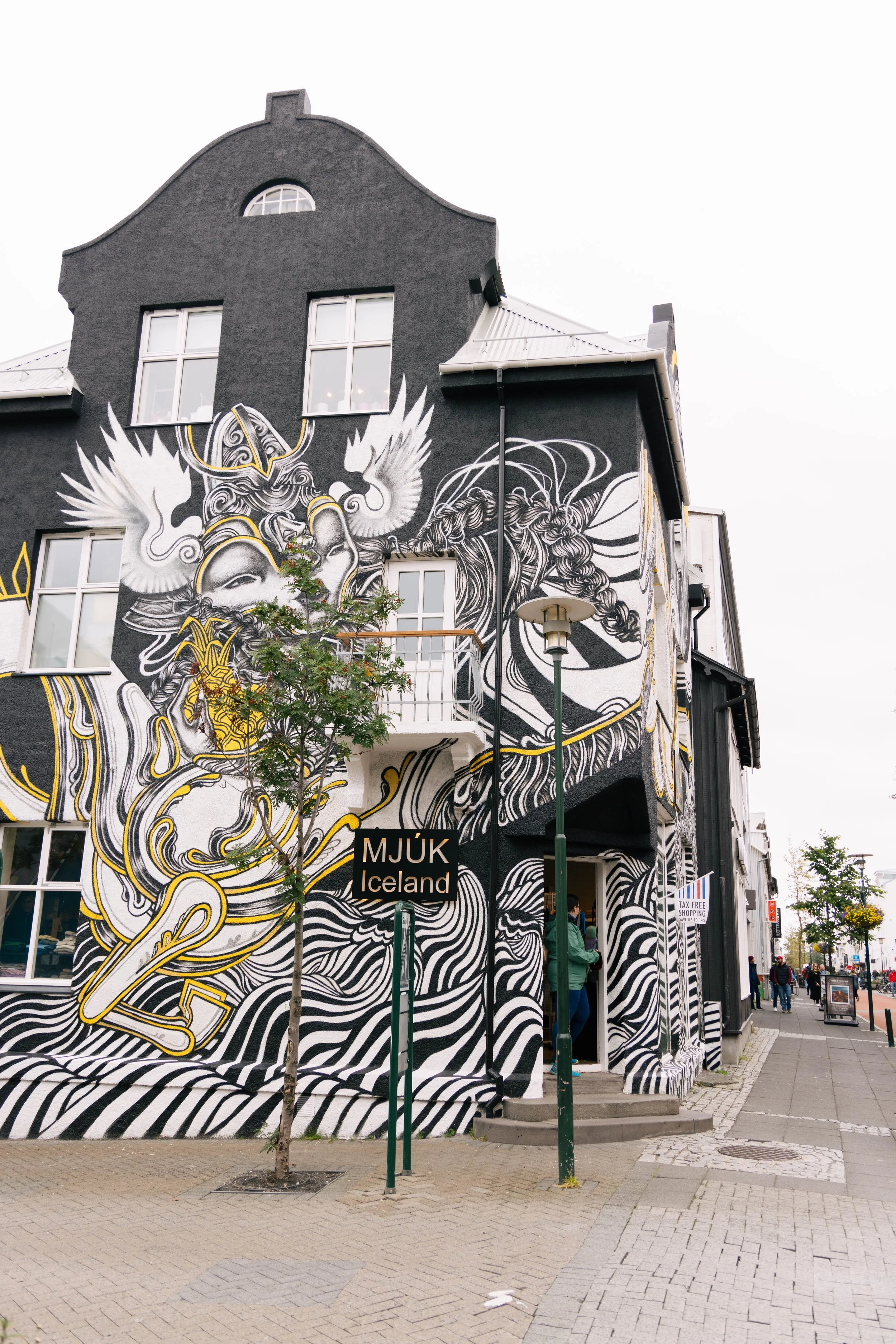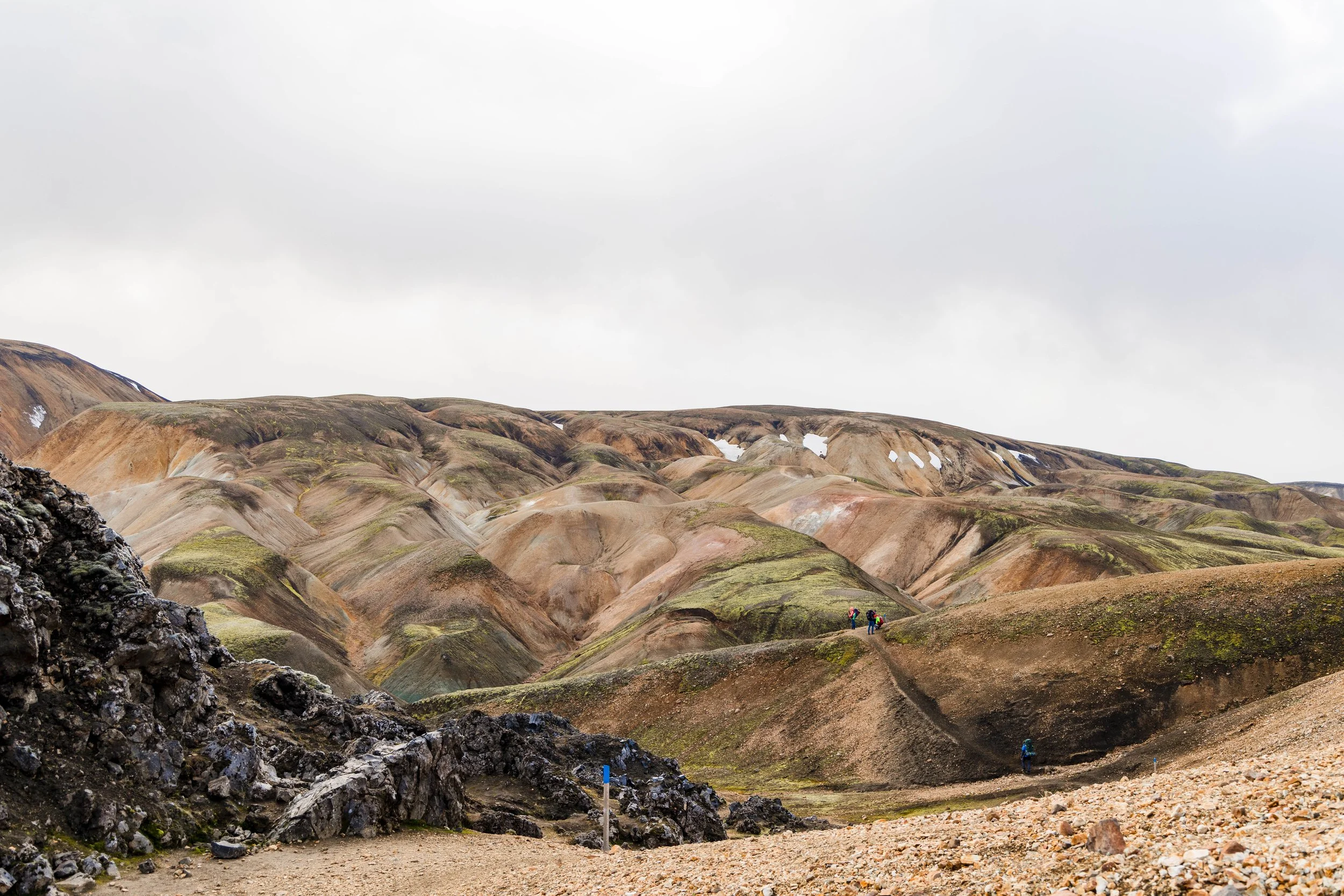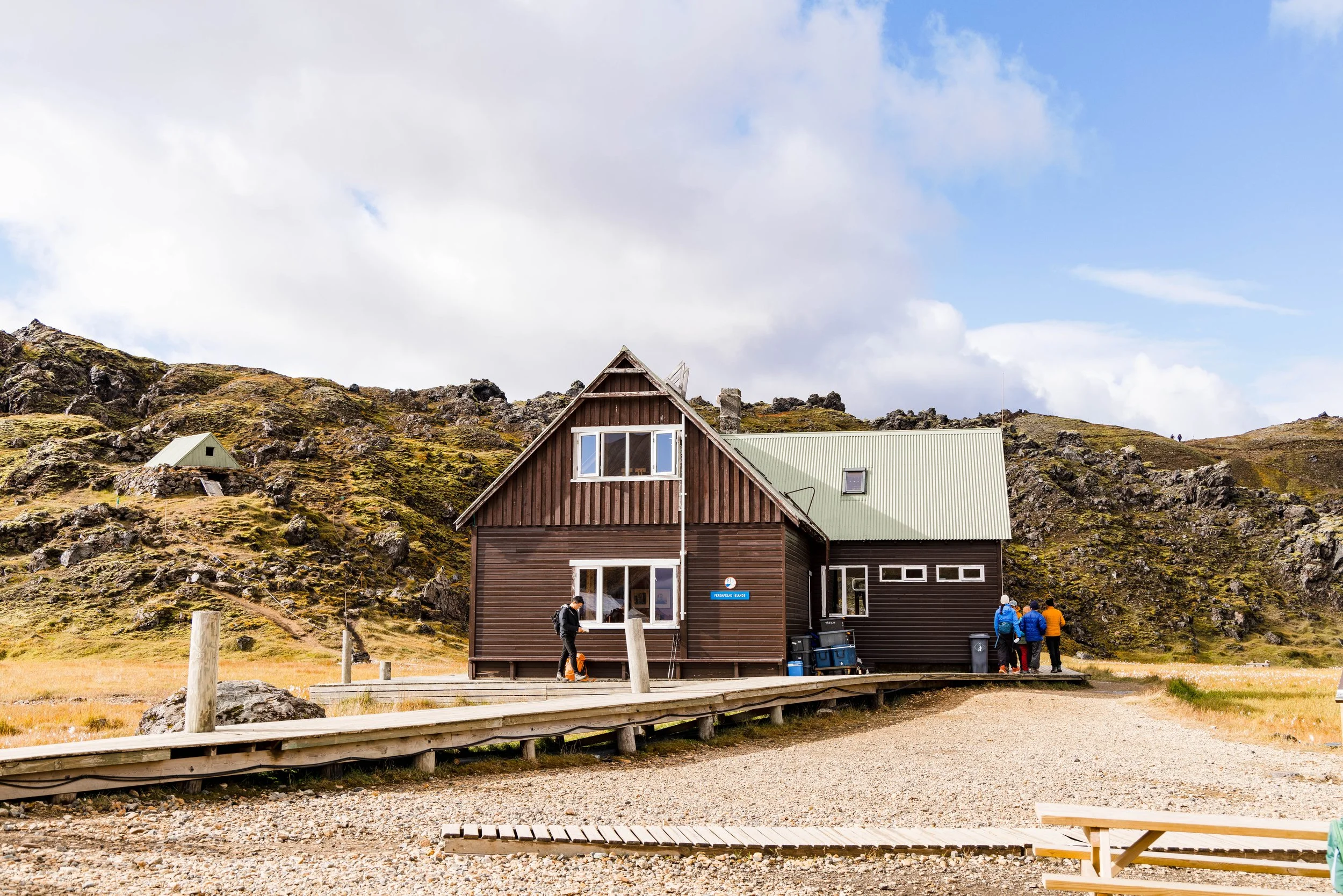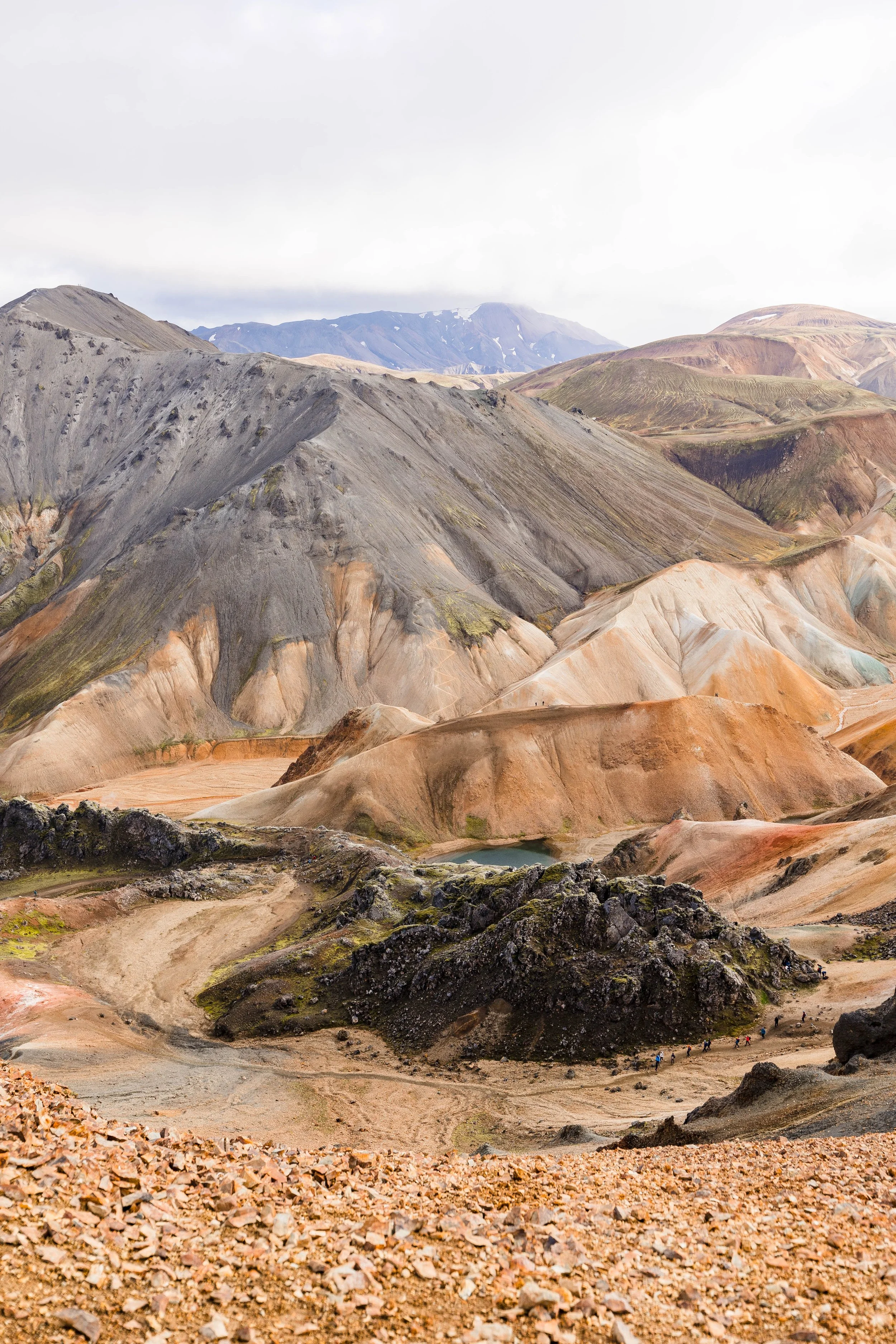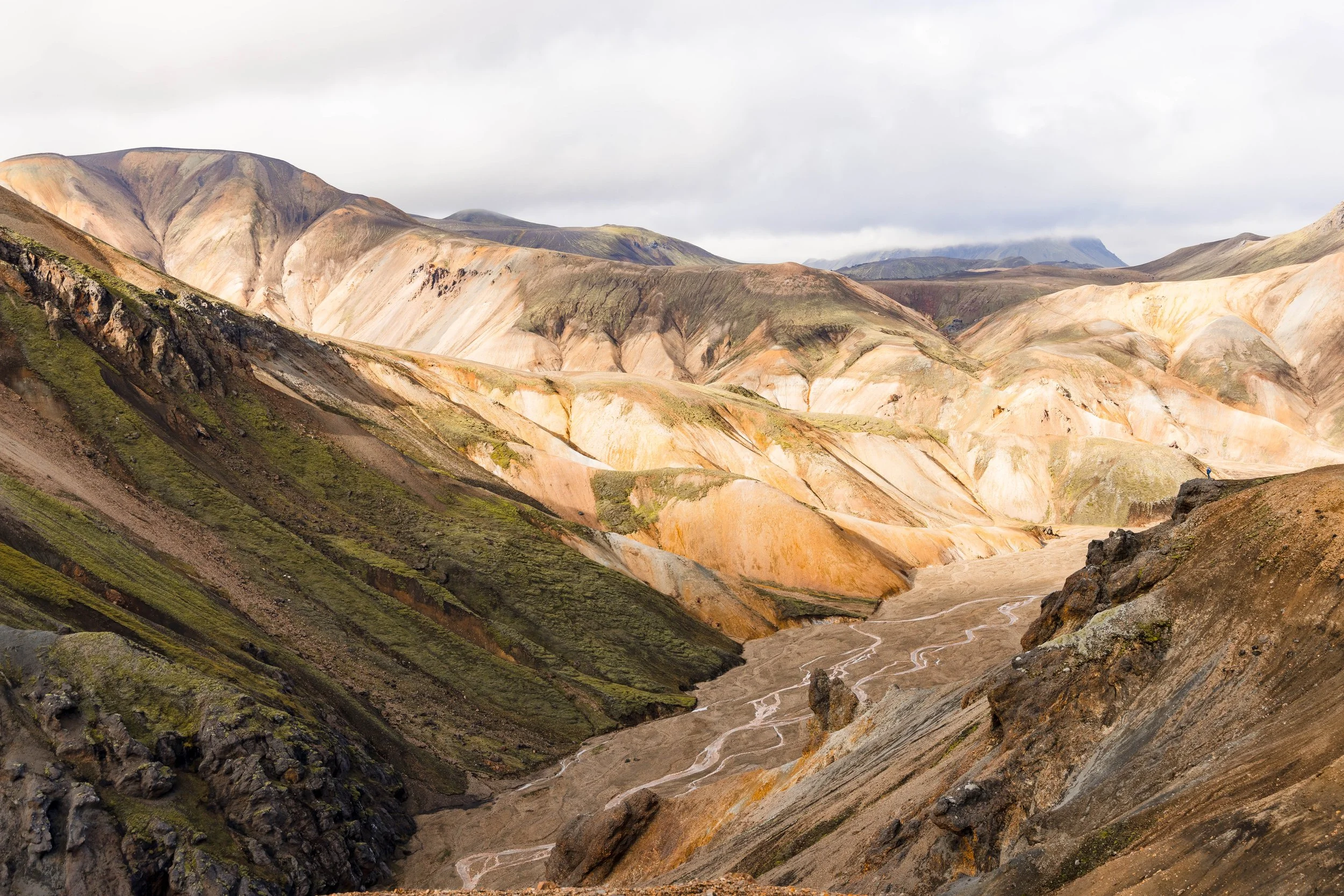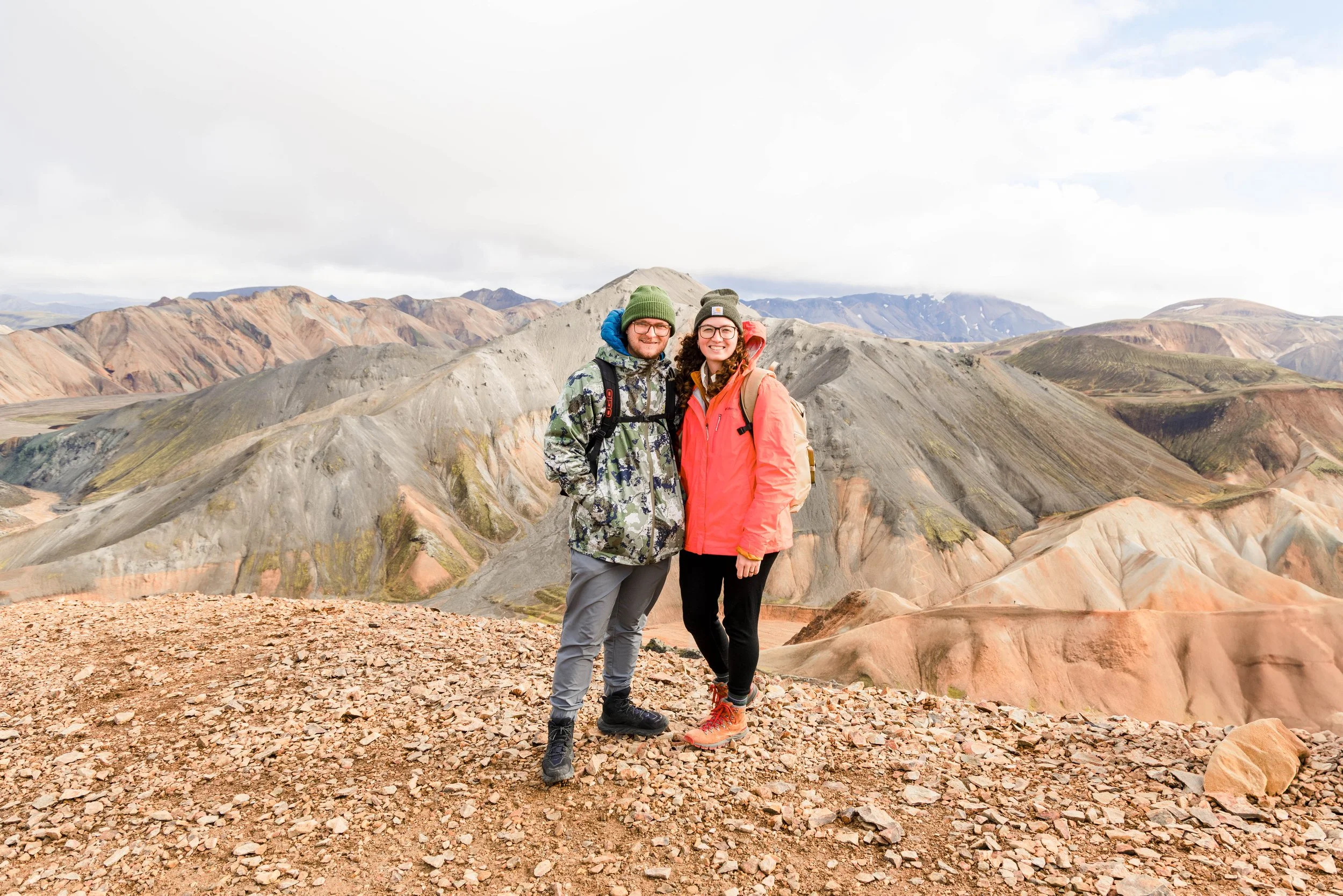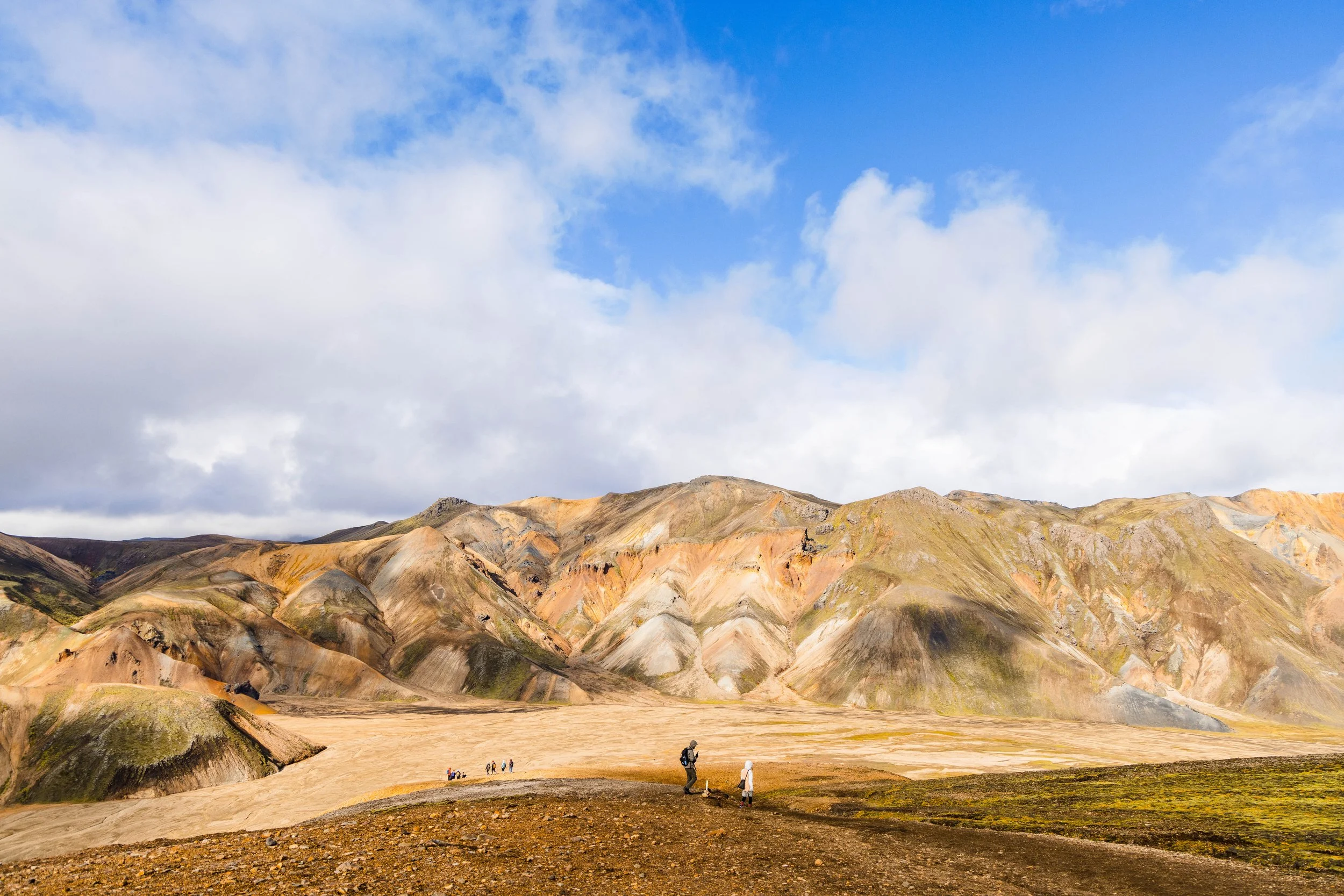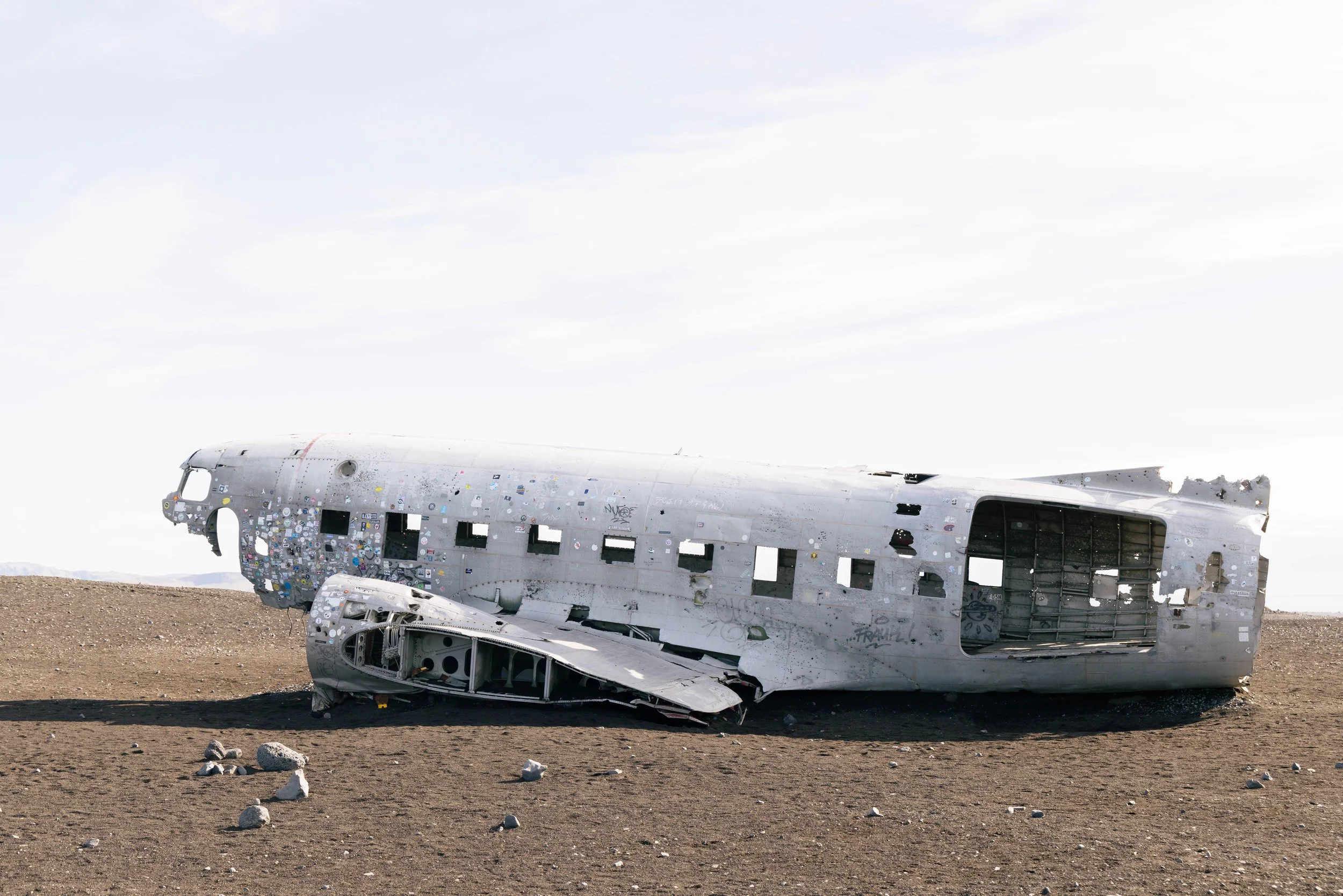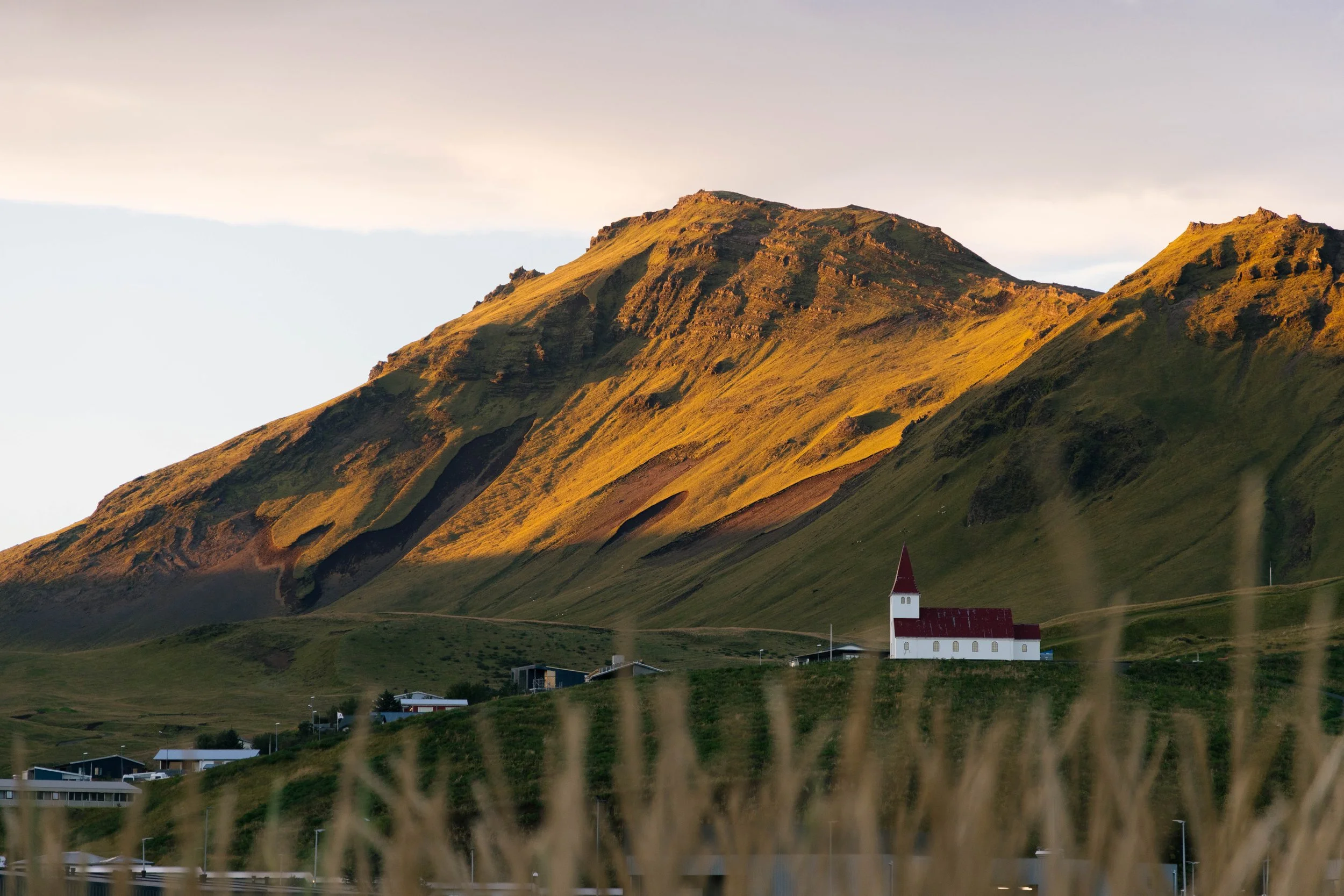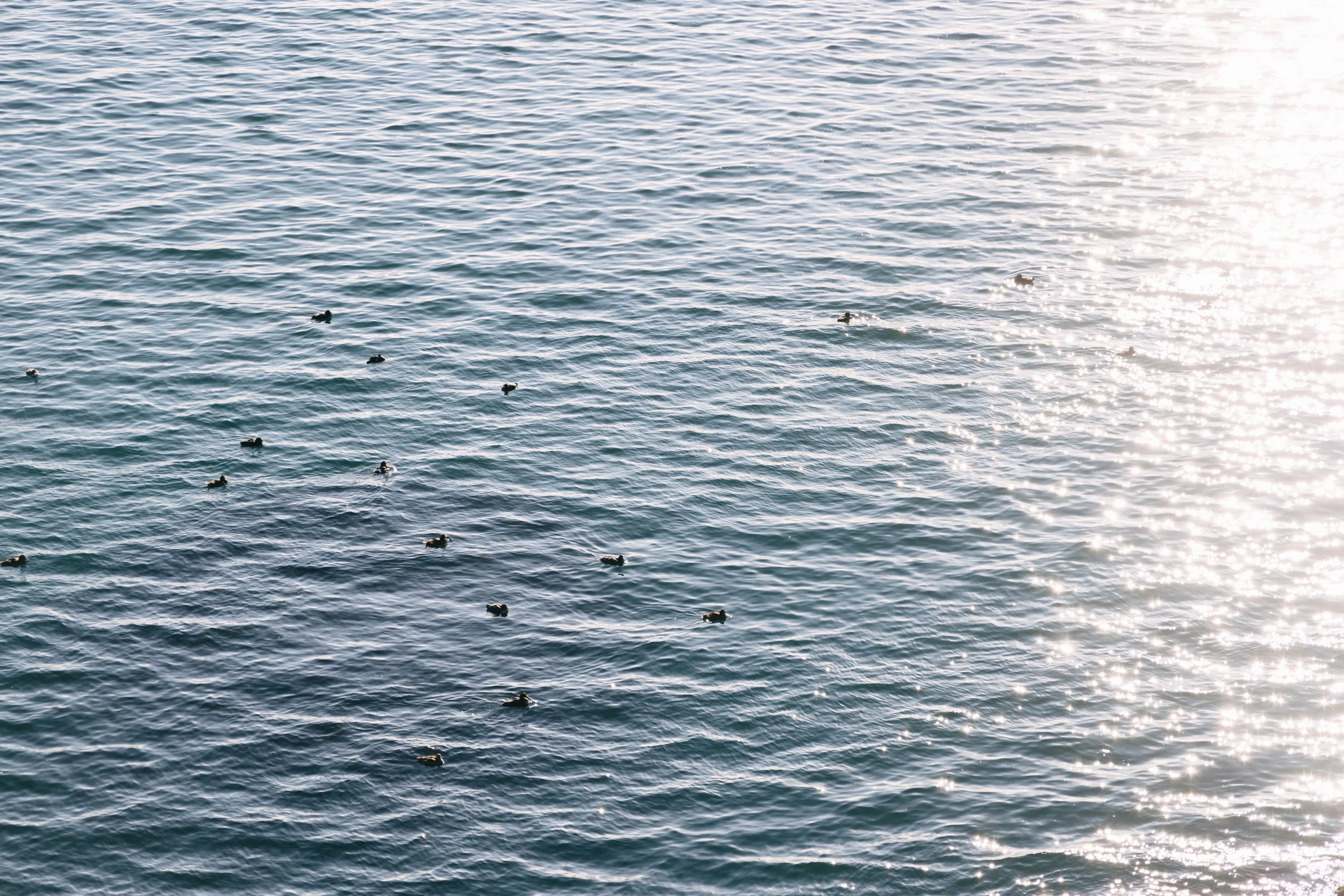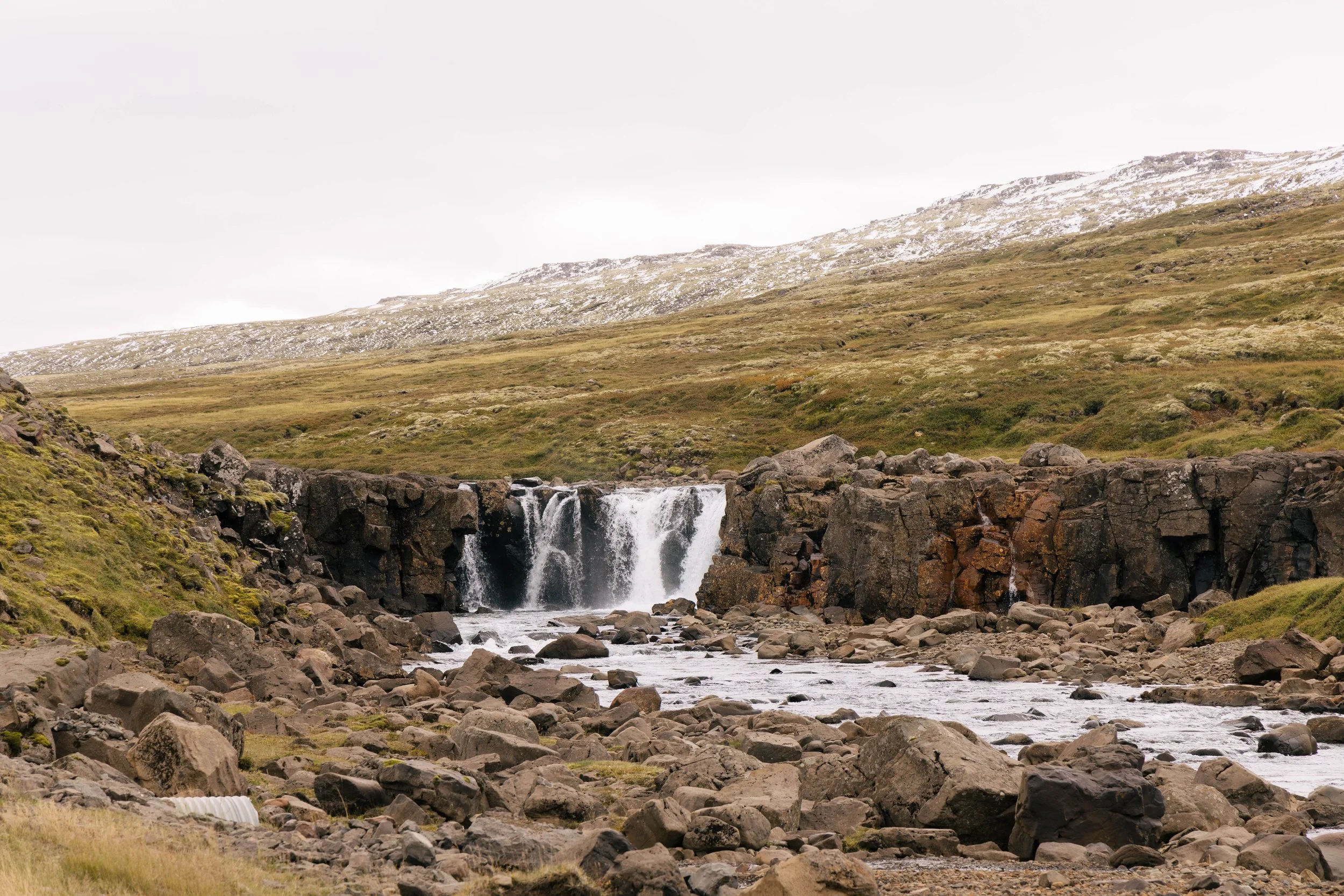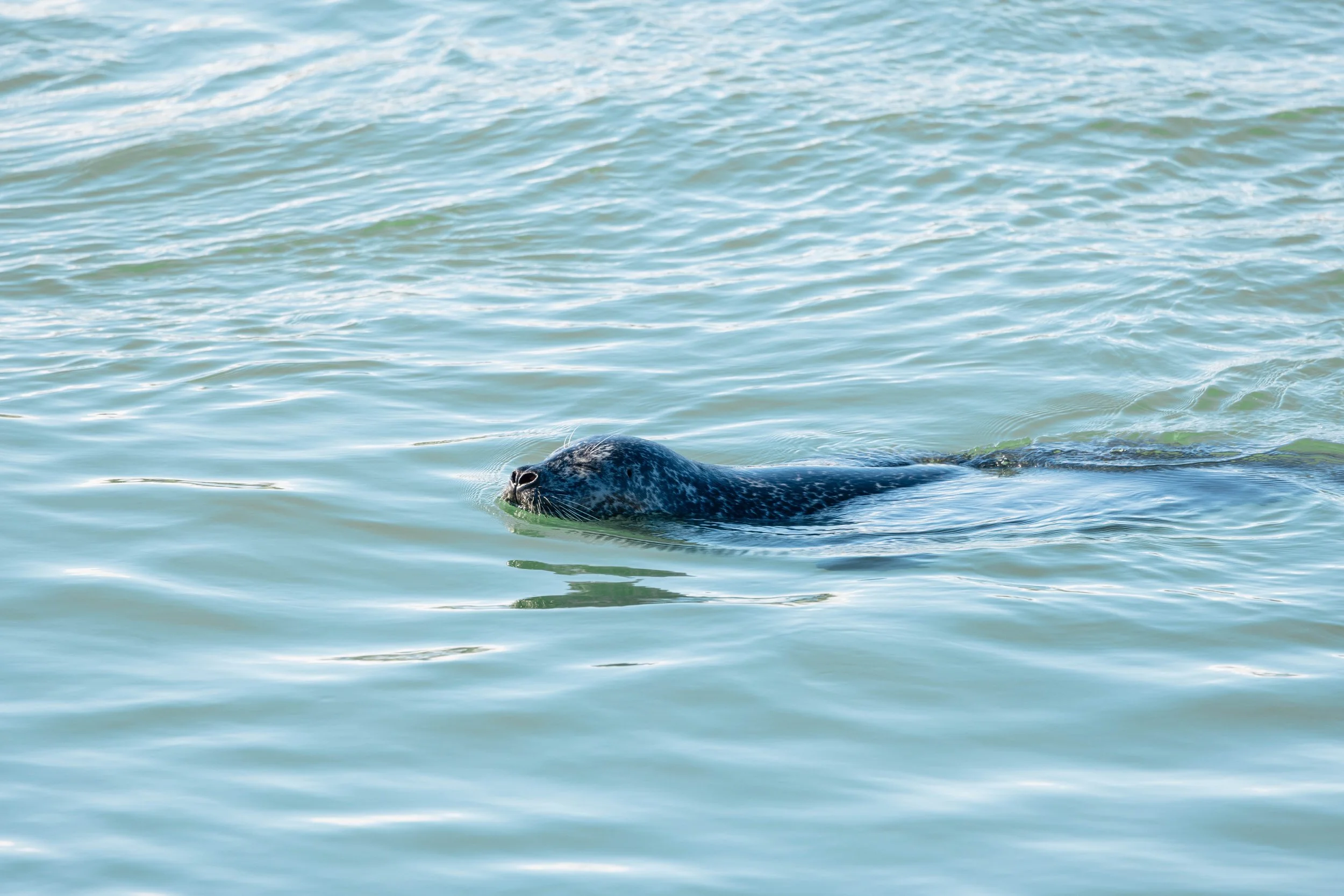Iceland - the land of fire and ice
This trip had been a trip in the making for YEARS. Seriously. Since 2020 we’ve been dreaming of traversing the rugged and beautiful landscape of Iceland. We planned this trip three times - once in 2020, then again for 2023, and then again for 2024 - the third time was the charm, and we finally went in September. We spent 10 days driving around the whole island in a camper van and wanted to share the views and our experiences along the way.
Overlooking the rhyolite mountains of Landmannalaugar
TIPS
Iceland is EXPENSIVE. Before we dive into the first part of the blog posts, the tips we suggest, here is a breakdown of what you can expect to spend while traveling around Iceland for 10 days. Some of these costs are flexible (flights, car rental, time spent there, gas, excursions, etc.), but expect to spend a good bit of money when traveling here.
Total cost broken down:
Flights: $1400
Camper-van: $1800
Food: $100 +
Campsites: $250
Excursions: $440
Gas: $900
Souvenirs: $400
Fishing License: $75
Parking: $75
TOTAL: $5,440
Flights: We flew Icelandair. We were going to fly PLAY Airlines, a cheaper airline (flights were like $600 total for 2); however, you have to pay for baggage, carry-ons, and seats. By the time you added up all the fees plus taxes for the airline, it was only $100 cheaper than Icelandair. Icelandair included a checked bag, seat selection, and a carry-on. They also had more leg room than PLAY, which was very important for us as we are both tall people! (Icelandair had almost five inches more of legroom than PLAY). So we ended up spending $1400 on flights for 2.
Food: We packed almost all of our food for our trip in giant ziplock bags in our checked suitcases. We packed a jar of peanut butter and jelly for sandwiches for lunches, granola bars, chips, crackers, snacks, etc., and hiking freeze-dried camp meals for our dinners. We purchased one meal out at a restaurant on our anniversary, and it cost us $70 for two. (I ate an appetizer and Grant ate a main course.) We purchased two loaves of bread throughout the week for our sandwiches, a dozen eggs, a few hot dogs from the gas stations (they were $2 and actually pretty amazing! They’re made of lamb, not pork like in the US. As someone who refuses to eat a US hot dog, I was wildly impressed with just how good Iceland’s hot dogs were), and a few snacks the last two days we were in Iceland. Packing food saved us SO MUCH money. We easily could’ve spent $1000 on food if we hadn’t brought it all with us. In total, we spent around $100 the whole week on food, including the meal we ate out.
Accommodations: We booked the AA Camper w/heater - automatic - Renault Kangoo camper-van from Kuku Campers. It was the first time for us ever renting a camper-van, so we made sure to get one with a sink, stove & cooler, and heater. Because we went in September, we were in the middle of fall in Iceland, so a heater at night was a must. And we’re so grateful we added it - we used it every single night! The camper included all the dishes and cleaning supplies for making food, along with a mattress for sleeping that converted into a table and bench seats. We did have to pay extra to ‘rent’ sleeping bags, pillows, blankets, camp chairs, and a camp table, but it was worth it because we didn’t have to pack and bring those items with us in a checked bag (we did bring our Rumpl blankets and I’d highly recommend some of those for travel! They kept us so warm). We also rented a portable WIFI hotspot (that we charged through a USB port while the camper drove), and a power converter so we could charge our laptops and camera batteries. If you brought your own sleeping bags, blankets, and pillows, it significantly lowered your cost of the rental. Our camper-van cost us $1800 for 10 days ($180 a day), which sounds expensive, but was significantly cheaper than trying to rent an Airbnb or hotel room everywhere we traveled. (Airbnb's on average cost around $200-$350 a night for the dates we were looking at) There were cheaper campers as well if you didn't want a camper-van with a heater, or if you knew how to drive a manual. The days were on average 3-10 degrees Celsius, and the nights even colder. We would have frozen if we hadn’t had the heater in the van overnight, so I’d highly suggest getting a van with one if you’re going in the cooler spring or fall/winter months. With the van, we had to rent campsites each night while we were driving. I tried to plan out our campsites ahead of time based on how long I assumed it would take us to drive to each location and how long it would take us to explore each location. Iceland is not like the US, where you can pull into a parking lot or off the shoulder and sleep for the night for free. There is NO legal free overnight parking anywhere in Iceland because every parcel of land in Iceland is privately owned by farmers. The government doesn’t own the land like in the US so you have to go to a dedicated campground.
Campsites: Unlike the US, most campsites in Iceland do not require reservations to use them. They are all pull up, park, and pay, with one exception. The only campsite we reserved a spot for was the Reykjavik campsite right outside of the city. This was the best campsite we stayed at with full electric hookups, showers, laundry, WIFI, and a breakfast cafe. Because we stayed here our first two nights in Iceland, we wanted to make sure our spot was reserved so we didn't have to drive far or scramble to find something when we were tired and jetlagged from traveling. This campsite cost us $23 for two nights. Most campsites cost between $5-$15 USD each night to stay at. In total, we paid around $200 for camping. We were very intentional about which campsites we chose. We wanted ones close to where we'd be adventuring the next day so we could hit sunrise and beat the crowds, but we also wanted sites with complete hookups so we could use our camper's heater, as well as ones that offered showers. At some campsites further away from the southern and eastern side of Iceland, you had to pay for the showers (typically 200 Kronas, which equaled around $2) because they were further away from the natural geothermal energy (they had to warm the water for your shower). We tried to work our showers around the campsites we were staying in, so we always had a shower included in our campsite price, so we weren’t paying any extra. We also wanted to make sure we always had water access to fill up our 10-gallon water jug in our van. All the water in Iceland is pure glacial water. No matter where you filled up, the water was drinkable. They had free water fill-ups at most gas stations and campsites all around Iceland, which was super convenient. Most campgrounds we stayed in also had shared food stations. Because camping around Iceland is so popular, people often need to leave behind extra food they purchased while traveling without throwing it out. So, if you need something, like dressing, ketchup, seasoning, a bag of rice, etc. Most campgrounds have shared food shelves where you can leave extra food behind or pick up what you need. It’s a convenient way to swap groceries if you’re in a pinch! We saw a lot of salt and pepper, as well as butane canisters. We were able to pick up butane from one of the campsites when we were running low without having to purchase a new can from a grocery store.
WIFI & connectivity: Most of the cafes and restaurants around Iceland had freely accessible wifi, so every time we stopped somewhere in a town, we were able to use it. However, we rented a portable Wi-Fi hotspot from our camper rental company so we could have access to the internet while on the road, especially for Google Maps (it cost around $100-$150 for the week). We had a printed map as well, but being able to access the internet while on the road was a lifesaver. I also purchased an electronic SIM card through the app Airalo, which allowed me to send and receive text messages; however, I still couldn’t make calls. The purpose of getting the electronic sim was to be able to call emergency services if needed, and it didn’t work, so I wouldn’t necessarily recommend it.
Water: Water in Iceland is the cleanest water you'll ever drink. So don't fall victim to purchasing bottled water at a grocery store. (We made that mistake once and attempted to buy water but ended up purchasing bubbly seltzer water. Don’t recommend that!) Bring a reusable water bottle with you and fill up at all the natural flowing streams around Iceland or at campsites. We rented a 10-gallon water jug when we reserved our van so we'd always have accessible, clean water. We filled it up every night at our campsites so we could fill up our bottles throughout the day as well as having water for cooking our dinners, brushing our teeth or washing our hands.
Money: Iceland is a cashless country (basically) unless you are paying for hot springs on private land. We used our credit card everywhere we went. When filling up with gas, remember your card has to have a PIN as some of the gas stations were unmanned. I downloaded a currency conversion app on my phone to help us with the exchange rate as we purchased things. It was SO nice to not have to do mental math!
Driving: Gas is VERY expensive! It was around $10-$12 a gallon. If you put your card into Apple Pay on your phone, it makes it so much easier to pay as you go around Iceland! Also, DRIVE THE SPEED LIMIT. Iceland has an extremely low police presence, but they have cameras on all of its roads, and they love slapping tourists with expensive speeding tickets if you don't watch your speed. In the shuttle from the airport, we were in the van with a few other travelers and overheard a conversation they were having. A friend of theirs went to Iceland the year before and ended up paying a $2,000 fine because the camera caught them going over the speed limit. 10 kilometers over the speed limit! So, don't go more than 5 kilometers over or you'll get a pretty big fine. We took our time and drove slowly. It's safer for you, for the locals, and for the sheep that cross the roads all the time! There are big warning signs before the camera “speed traps” so you’ll see them coming.
Parking: The most annoying part of exploring Iceland is that anytime you stop at an attraction, you have to pay a parking fee. All of the waterfalls you hear about (Skogafoss, Hengifoss, etc.) are all on private owned land by farmers. The farmers charge a fee to take care of the upkeep of the parking lots and drives. Most parking fees could be paid for on the Parka app on your phone, or they had a QR code you had to scan to follow a link to pay for. Most spots ranged from $7-$10 per spot though, so keep that in mind when planning locations. Don’t skip on paying - all of the spots we stopped at had hidden cameras that snapped a photo of your license plate if you didn’t pay, and they then charged your rental car company.
Blue Lagoon: The Blue Lagoon is one of National Geographic's 25 wonders of the world. This was really the only reason we added this spot to our list. When we travel, we try and hit up all the big, unique things around the world, and we try to avoid the overly touristy destinations. Originally, this lagoon was not even on our radar because it was hyped up as super expensive and over-touristy. However, we decided that if we were going to Iceland, we wanted to hit up all the real experiences. Even though we consider ourselves travelers, we really are just tourists when we go to new countries. It is catered to tourists, so everything about it is expensive, but if you think of the expense as part of your Iceland experience, it makes it better. We spent $190 on 2 tickets for a 9:00 am time slot at the lagoon. Later times were more expensive, so if you're looking at booking, make sure you pick the right time slot for you. We picked the Comfort package, which is the most basic package they offer. That included a silica face mask, one drink in the lagoon, and the use of a towel. You could upgrade to the other packages that included things like a robe, a dinner reservation at their restaurant, more silica masks and drinks, and access to their spas and private changing rooms (more on the changing rooms later). First thing in the morning is usually cheaper because tourists (like you and me) are typically sleeping in. You can reserve a table at their restaurant there for lunch or dinner, or grab little to-go snacks from their cafe. Be aware that Icelanders are not as modest about changing as Western cultures are. It was a surprise for me when we walked in and women were just stripping down in front of their lockers. You are given a wristband to connect to a locker where you leave all of your stuff. The wristband also acts as a card when you're in the water and getting drinks from the bar. They require you to shower naked (please use body wash and soap!) before putting on your swimsuit and heading out into the lagoon. Because I was pregnant, Grant and I tried very hard to pay attention to the hottest spots of the lagoon and to stay away from those areas. It’s advised not to be in water temperatures warmer than 98 degrees when pregnant, so with clearance from my doctor and directions from the lady at the front desk, we hovered in the cooler spots of the lagoon. We got drinks at the bar before settling in the cool spots to relax. (They were still plenty warm!) We were grateful we got there as early as we did, because even though we didn't stick around long (I got way too hot) by the time we left only an hour and a half later, lines of people were waiting to get in.
Natural Hot Springs: There are a TON of natural hot springs around Iceland. Some are free, some are on private land, and some cost a few dollars to get in or to park. Keep that in mind as you are touring around. We didn't do any natural hot springs other than the Blue Lagoon, but many people love to visit as many as they can.
F-Roads: Do not, and I repeat, DO NOT drive down any F-Road unless you have a 4x4 vehicle! You will either break your car, pop a tire, or get stuck. The roads are labeled as F-Roads for a reason. They are ROUGH. Our vehicle was not a 4x4 (they're typically more expensive), so we chose to do a guided tour to an area we wanted to see that required F-Roads to access. If we had to do it again, we'd rent a 4x4 vehicle in a heartbeat. Some of the roads that led to locations were dirt or stone roads and were full of potholes. Navigating them was definitely kind of sketchy at some spots.
Excursions: Booking excursions with guides is seriously the greatest way to see the best parts of Iceland. It’s the path I’d recommend 10x over. The only two tours we paid for were the Blue Lagoon and a guided day tour to Landmannalaugar. The Blue Lagoon cost us $190 for two people, but that was a morning time slot. If you booked a later timeslot, you could spend up to $250. Our guided tour to the highlands of Landmannalaugar cost us $350 for 2 people for an 11-hour tour on a tour bus. I cannot recommend this trip enough! We had amazing tour guides who took us on a 3-mile hiking tour through Landmannalaugar. The views were incredible, and it paid for itself. We had planned on doing a third excursion, but ended up having to cancel it. We were going to snorkel the Silfra Fracture, the only place in the world where you can snorkel between two tectonic plates. If we had gone snorkeling, it would have cost us $250 for two of us for a 4-hour snorkeling tour. That included drinks and snacks after our swim, as well as all the gear that would allow us to do it.
Packing: Pack in layers! We packed lots of thermal underwear and merino clothing like leggings and long sleeves. We both definitely overpacked. I rotated through three pairs of merino leggings and three long-sleeved merino shirts the whole entire trip. Even though we were there for 10 days, we definitely didn't need more base layers than those. We both brought rain slickers, as well as rain pants to wear over our hiking pants or leggings. Purchasing rain pants before our trip was the best thing we did! Not only did they keep us dry on the days that it rained and around waterfalls, but they were great to wear as a windbreaker for our legs on the windy days, which helped keep us warm. Good hiking boots are a must, and I also brought a pair of waterproof sneakers for the flights and my trusty pair of Blundstones. Whatever shoes you bring, make sure they're waterproof or that you have multiple pairs (especially socks!). I brought a heavy fleece sweater from LL Bean, a heavy flannel, a puffer coat, a hat, gloves, a scarf, and lots of thick, warm hiking socks. I never wore my scarf, but we both wore hats and gloves just about every day. Don't forget your swimsuit if you're planning on going to hot springs, as well as a pair of quick dry sandals or rubber sandals that you can wipe off to dry for showers and hot springs. We also packed quick-dry towels for showers at campsites and for swimming.
Camera Equipment: This was probably the most important thing we packed. Being professional photographers and videographers, we wanted to capture our once-in-a-lifetime trip in the best way possible. We brought with us:
Canon R5
Canon R6
Canon L 24-105 f4 (the most underrated and most used lens)
Canon L 15-35 f4
Canon L 100-500
Mavic Mini Drone
GoPro Hero 11
We wanted to bring the drone to capture the incredible views where we could. However, a lot of tourist attractions and areas in Iceland do not allow drones, so do your research before you go. We found plenty of places to fly it, and we were able to get some incredible footage. We also brought the GoPro for when we were near the waterfalls, or in the Blue Lagoon, because I didn't want to bring my big camera in the lagoon; however, we didn’t really use it. I didn’t bring any equipment with me into the lagoon, and I don’t regret it.
VAT Tax Refund: When you are purchasing items in Iceland to take home as souvenirs, make sure to hang on to your receipts and ask for Tax-Free receipts. When you go to fly home, there is a counter in the airport where you can take your receipts to and get a refund for all the tax money you spent on the items you've purchased. This is directly from the government of Iceland website:
“Tourists who reside abroad can claim a proportional VAT refund when shopping in Iceland. The refund is limited to purchases that are intended to be taken out of the country and amount to a minimum of ISK 6 000 (including VAT), made at a single point of sale. The store personnel will fill out the necessary Tax Refund Cheque. The cheque and the purchased goods must be produced and made available for inspection in Iceland on departure, no later than 3 months after purchase. When departing from Keflavik Airport, the Tax Refund Cheque can be cashed in the currency of choice. Other departure points usually offer mail-refund services."
ISK 6 000 is roughly $44 USD. Anything over that purchase price is fair game for a Tax reduction! Here is a little bit more about it:
“If you purchase items in a local store and are going to export them from Iceland, then you should ask in the store for a Tax-Free form. The form is filled in by the store, and the original purchase receipts are attached to it. When you leave the country,y you take the goods purchased, the tax-free forms, and the receipts to Change Group in the airport or if the amount is higher than 100,000 ISK to the customs office to have the form stamped and thereby export validated. You then take the tax-free forms, together with the original purchase receipts, to the International Refund Point and get your refund."
So remember when you're traveling to ask for the tax-free form when making purchases to make sure you get your refund at the airport. They refund it right back to your card in your currency within 30 days.
Gullfoss Waterfall
Itinerary - 10 days
Day 1: Flight day. We had a red-eye out of BWI to Keflavik Airport, so we landed at 6:30 AM Iceland time. We had to catch breakfast at the airport and wait until 8:00 AM when a shuttle could take us to the place where we were to pick up our camper-van. We HIGHLY recommend renting a camper-van or a car with a tent on top for your stay. (It really is the BEST way to see all of Iceland without booking multiple accommodations or driving miles and miles each day.) After picking up our camper-van, we drove straight to the Blue Lagoon for a relaxing entrance to Iceland! We booked the 9:00 AM time slot, hoping that was still early enough to avoid most crowds, and it was the soonest we could get there after picking up our camper.
Things to note about the Blue Lagoon. The culture of Iceland is very open compared to America. Meaning, modesty isn't really a thing. When you change into your swimsuit, the changing rooms are all very open, locker-room-type rooms. There are private stalls for showers or public stalls without doors. It is a requirement to shower (naked) before putting on your swimsuit and heading out into the lagoon. It helps keep the water clean for everyone. We purchased the basic comfort package that included a towel but no robe. The basic package also meant that you changed in the shared changing room with everyone else. Their highest package includes a private changing room and shower room for you and your partner when you arrive, if that is something you want to spend the money on. When you shower, make sure to wash your hair and coat it in the conditioner (don't wash it out!) before heading out into the lagoon. I kept my hair up in a clip so it never touched the water. The Blue Lagoon has high levels of silica and minerals in it, which feel great on your skin but not so much on your hair. I never dipped my hair under the lagoon water, and was very careful to make sure it stayed up. I had heard all kinds of horror stories of the high mineral density water frying people's hair and making it crispy for weeks, and I wasn't about to let mine get that way!
We stayed for about an hour (it started to get really hot for us to be in it much longer) before heading into downtown Reykjavik to grocery shop (we went to Bonus, it's the cheapest grocery store in Iceland), before walking around downtown Reykjavik. We ate dinner downtown at the cutest little cafe and got the BEST tomato soup and grilled cheese sandwiches before heading early to our campsite just outside of town to settle down for the night. Iceland is known for its tomatoes. Because of their climate, they are one of the only vegetables that can grow successfully!
Day 2: We drove the Golden Circle. If you only have a few days in Iceland, this is the most recommended loop to hit. If you see this before the rest of Iceland, it’s worth it. If you intend to hit this up as your last stop, you might as well skip it. It isn’t as impressive as you think once you’ve seen the rest of Iceland’s wild beauty. We started our day off by touring Kerid Crater, Geysir, and then heading to Gullfoss. “Foss” In Icelandic means “waterfall”, so we tried to hit up all the “foss” places we saw on the map. We missed Brúarhlöð, and we’d recommend stopping to see it on your way to or from Gullfoss. After Gullfoss, we drove through Thigvellir National Park and stood where the Eurasian and the North American Tectonic plates met. You can snorkel at the Silfra Fracture here - we were supposed to, but had to cancel because I (Holly) was pregnant. We ate dinner at a beautiful little off-the-road spot and Grant fished to end the evening. We ended up camping in Selfoss this night so we could catch the bus for our first excursion the next day.
Day 3: Day 3 started EARLY! This was our tour day with Arctic Adventures to Landmannalaugar! I was SO excited for this part of our trip. The highlands are incredibly diverse, beautiful, and hard to reach. (Hello F-Roads) Because we did not rent a vehicle with 4x4, we could not access any of the F-Roads ourselves. This tour what we were looking forward to the most. The bus picked us up at 6 am at the gas station a few minutes from our campsite in Selfoss. It made two more stops before making the rest of the way through the rugged highlands. We drove over thick black sands, rough rock roads, and saw some distant sheep rummaging in the mountains. When we arrived in Landmannalaugar, we split into two groups and followed our tour guide. We explored the famous Laugavegur Trek, a renowned hiking trail consistently rated as one of the finest hiking trails in the world. We saw incredible multicolored rhyolite mountains that changed color as the sun hit them and the impressive Laugahraun lava fields. The hike was HARD, the most difficult stretch being the shortest stretch to the very top. The winds picked up significantly, and the temperature dropped by around ten degrees as we climbed our way up to the top. Once we were at the top, though, we enjoyed the incredible views and spent about half an hour relaxing before heading down the other side of the mountain. The three-mile trek was so worth it at the end. Most of the people on our hike chose to end their hike with a soak in the natural hot springs there, but Grant and I both chose to relax at the picnic tables, talking with some of the other hikers. Pro tip: altitude sickness is real. I brought a bag of ginger chews because I was battling intense morning sickness on our trip, and they not only helped me but also another hiker who was nauseous. We then rode the 4 hours back out to Selfoss, and ended up back at our campsite in Selfoss at around 10 pm.
At the bottom of this image, if you look at the trail, you can see people hiking!
Day 4: We began driving the Ring Road on this day, heading East towards Vik. The first waterfall we hit was Seljalandsfoss. There was a hidden waterfall here called Gljufrabui that is slowly becoming more popular that we somehow accidentally missed. From here we could’ve stopped at Seljavallalaug Swimming Pool, the oldest natural swimming pool in Iceland (but we skipped it for times sake) and instead headed straight to Skogafoss. We loved this waterfall! You can view it from the bottom as well as hiking to the very top of it (we skipped this because I was sick). You can also hit up Kvernufoss after this on your way to Dyrhólaey. Before we hit Dyrhólaey, we parked, ate lunch, and then hiked out to see the Solheimasandur Plane Wreck. This was a good long walk. It’s completely flat, and there is a shuttle that you can pay to drive you to the plane wreck and back, but we wanted to save the extra cash and just walked it. We hit it at a great time where we were kind of inbetween shuttles so we managed to get a few pictures without tourists in it before it was flooded with people again. From the plane wreck we went to Dyrhólaey lighthouse, and then we went to Reynisfjara Black Sand Beach to see the basalt columns. We ended our night in Vik at the Vik campground with a gorgeous sunset overlooking the traditional white church and black sand beaches. We absolutely loved Vik. It was a very small town nestled between the towering mountain and the coast, with little shops here.
Solheimasandur Plane Wreck
Day 5: This day started out with a terrible wind advisory from our camper company. Our goal had been to head North to Hofn but with the winds and sands blowing we ended up turning around and heading back towards Reykjavik. We saw the famous Yoda Cave, and were the only ones there! This was our only sight seeing stop this day as it took all day to get from Vik to the Snorrastadir Farm Holidays, our campsite for the night. We did see lots of sheep and our first Icelandic horses of the trip however and we stopped several times to get some good pictures.
Day 6: This day started with sheep sightseeing before heading towards Snæfellsjökull National Park. We stopped at the famous Black Church in Búðir, the cliffs of Arnarstapi, and Kirkjufell Mountain. The roads were incredibly windy but beautiful, offering a completely different side of Iceland. There were no lava fields to be seen, and we drove through snow-covered passes. It was also a very long driving day for us. Grant spent the evening fishing, and afterwards we went to our campsite for the night in Akureyri. Akureyri is unique because all of its stoplights are hearts. We didn’t give ourselves time to explore the city, though I wish we could’ve - we got in at sunset to head to our campsite for the night and then left early the next morning. We stayed at Hamrar Campground. It was a very family friendly campground, with playgrounds for kids and buildings for showering and bathrooms. Showers were free here (yay!) and they had large waterhook-ups to refill your camper. Half the campground was closed down when we arrived because they were preparing for winter, but we still managed to get a good camp spot right next to the bath house. The showers were hot, there was an out kitchen for brushing our teeth and washing dishes and it was relatively quiet once the sun went down. People are generally very respectful here. When we woke up the following morning it was so cold the water hose was frozen so we couldn’t get fresh water and fill our tank. Rookie mistake that we did not make again the rest of the trip!
Day 7: From Akureyri we drove clear across the Northern Part of Iceland to end the night in Hofn. There is not a lot to see in the northern part of Iceland, except for a few waterfalls and the Myvatn hot springs. We skipped Myvatn, and instead stopped at a few waterfalls, and Stuðlagil Canyon. There are two ways to fiew Stuðlagil . you can view it from the main viewing platform, or you can drive down a short dirt road, park, and hike two miles back to where you can climb (a very sketchy slippery path) down into the canyon to see it from the bottom. Because of time and how sick I was, we opted to just view the canyon from the main viewing platform. They were doing construction on the road so it was just a dirt road and it was pretty sketchy to drive down without a 4x4 vehicle. Again, we’d highly recommend getting a 4x4 vehicle for your driving adventures! The canyon it self was beautiful, but there were SO many people, and you couldn’t see the canyon very well from the viewing platform. There are a LOT of steps to get down to the main part of the viewing platform, so be warned. There were over 100+ we counted!
From Stuðlagil we continued to drive and ended up driving on a dirt mountain road that was very steep, full of pot holes (you had to go SO slow or you could’ve popped a tire) and lots of sheep. It was the only road that was open to get down to Hofn, however, so we had to take it. The winds were horrible that day, and our camper rocked the whole way. At one point, when we got out of the van, the winds were so strong they kept us upright when we leaned all our weight backwards! After spending most of the day in the van, we finally made it to Hofn for the night. We ate out at Otto Matur & Drykkur, the only restaurant we ate at on our whole trip. It was SO worth it (but very expensive). I (Holly) ate the famous Lobster bisque soup, and Grant had arctic char. They served freshly made sourdough bread with fresh churned salted butter, and my friend, if you have the option to eat here, DO IT. The bread & butter was so amazing!
We camped at the Vestrahorn campground this evening. We got there right before dark, and there were only a few spots open. You pay at the Viking cafe, and it includes access to the Viking village, which was a score. If you didn’t camp there overnight, there was an extra charge to access the Viking village if you wanted to walk it or go down the dirt road to the coast. The bathrooms here were tight, and there were constant lines with how many campers were there. They also did not have showers.
This night was the most special night in Iceland for us… we saw the northern lights for the first and only time our whole trip! They came out shortly after 9 pm and lasted for a full 40 minutes. We got some incredible shots, and were so thankful we got to experience them!
Day 8: Today we spent the day exploring the Viking Village and Vestrahorn, before driving down the coast to Vik. The Viking Village was modeled after what a real village would’ve looked like with the earliest settlers to Iceland, however, it wasn’t real. It was used to film several movie sets, however, and the little cafe that was next to our campsite had posters from all the movies that were filmed there. It was a neat little place to explore, and we had it all to ourselves. After that, we drove our van down to the tip of Vestrahorn and explored the black sand beach and the cliffs there. We were luckily able to spot some seals, the highlight of my morning! After leaving Vestrahorn, we hit up Diamond Beach and Jökulsárlón Glacier Lagoon. Jökulsárlón was incredibly busy when we arrived (around lunchtime). Here you can do a boat excursion and go kayaking or cruising around the glaciers. We enjoyed our time at Jökulsárlón (they have bathrooms!), we saw lots of seals, birds, and we enjoyed lunch at one of the many food trucks that were parked there. We walked from the lagoon under the interstate pass to Diamond Beach. It was an easy flat walk, and it was super great because we didn’t have to move our vehicle then and pay for parking again. Because we hit it in September, there were no large chunks of ice on the beach like the famous photos you always see. I’m sure if you came in March or April, you’d get the large glacier chunks. After the lagoon, we finished our night off exploring Fjaðrárgljúfur, a beautiful canyon with a crystal blue river running through it. You have to hike to the top to look back and see the best view of the canyon, but it was worth it! We camped in Vik this night so we could drive back to Reykjavik the next day.
Day 8: Our night in Vik was the worst weather night we’ve ever experienced, so we started this day at sunrise with no sleep. A horrible windstorm blew through Vik with 40+ mile per hour winds. Our camper rocked with the force of the wind and the rain, and we spent all night praying we didn’t tip over into our neighbor's camper. We spent the day driving back to Reykjavik, and explored downtown souvenir shopping and grabbing dinner before going back to the Reykjavik campground to spend the night. We got the best ice cream at Skubb for dessert (thank you, Brea Burkard, for the fantastic recommendation!) & started. packing up for our flight the next day.
Day 10: We packed up our camper, took our last showers, and took our time driving around Reykjavik, bakery hopping for the best pastries for breakfast, before moving to our van rental company and heading to the airport!
Overall, we had a great time! However, if we’d do it again, this is what we’d recommend:
Go for 5-7 days. You don’t need more than that unless you are driving the whole island, and here’s why: The best views are on the Southern and Eastern coasts. We were ready to go home by day 8, and tired of spending days driving around in a van. The western and northern coasts have little to offer in terms of hiking, waterfalls, and unique, typical tourist attractions.
Get an Airbnb or hotel in Reykjavik, and rent a car to see the rest of Iceland. Reykjavik has everything you need - grocery stores, shopping, food, and acts as a great base for day trips and tours.
Speaking of tours, DO THEM. Do a guided glacier tour. Do a guided 4x4 tour to Landmannalaugar. Do a guided Northern Lights Tour. Do a boat tour for whale watching. Do a traditional horseback riding tour. These are the best and safest ways to see all that Iceland has to offer. And you get the unique experience of learning from a local!
We hope you have an AMAZING trip to Iceland! I know we’re looking forward to going back ourselves!

